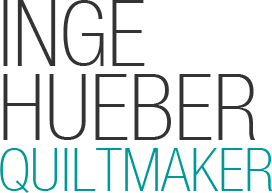Publications
Dialogues and Small Talk
book/catalogue 2015
Inge Hueber
by Dr. Sue Marks
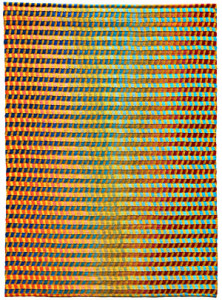
Colourscape, 2014 (200 x 146 cm)
Working in fabric for Inge Hueber was a natural choice, a medium with which she was familiar, but when she began making quilts in Cologne some thirty five years ago, she was working alone. Germany is a country without an historic quilting tradition, something Hueber thinks worked to her advantage, allowing her freedom to develop a unique visual language unhampered by rules and expectations. An understanding of Germany’s strong modern design tradition that dates back to the Bauhaus is, however, evident in Hueber’s work. It shows in her assured use of materials, her handling of composition, colour and construction, and in her clean looking, unadorned work.
Using pure, solid colour is fundamental to her ethos and typically, she explores how different colours react to each other, making large, expressive, abstract works. These dynamic and beautiful compositions shimmer, as colours appear to chase each other across the quilt surface. The recent ‘Broadstairs’ series had more tangible subject matter, the memories and emotional response to a place Hueber loves and has visited for over thirty years, and captured in photographs. ‘Colourscape’ returns to her roots and is a celebration of colour, where deep pinks and ocean blues in gently graded shades are separated by bands of warm yellow. When asked about her use of yellow, the dominant colour in ‘Colourscape’, she said it symbolised the power of light and sunshine, reflecting that basic need for light for most living creatures. Working with colour makes Hueber happy and she seeks to provoke a similar response in viewers. Though she has studied Johannes Itten’s colour theories about how colour affects people, her work is also the result of years of experience, a deep rooted and instinctive knowledge of how colours work together and of how to work with colour.
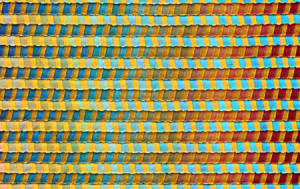
Colourscape detail
Over the years, she has built up a vast collection of home dyed fabrics, which she cut into the strips that form the foundation of her quilts. Her dyeing process involves only the commercially produced Dylon, cotton and an old fashioned washing machine. The palette of hues available are mixed to produce the myriad of colours in numerous shades that so characterise her work. Her method of construction is similarly straightforward, the Seminole technique, where strips of fabric, sometimes of different widths, are stitched together, cut, and re-sewn into a variety of patterns. These deceptively simple beginnings belie the complexity and artistry of Hueber’s work. This work has continued to evolve whilst she has held fast to her original self taught methods of production. Her low tech approach stands apart in a textile world that has becoming increasingly sophisticated, embracing modern technology and a plethora of gadgetry and products in a seemingly never ending quest to produce more and more complex textiles.
Preparation for work involves a period of reflection, sometimes lengthy. There is no preliminary sketching or photographs, or even note taking. The studio floor becomes her ‘sketchbook‘, as the coloured fabric and strips with which she wants to work are laid out, arranged and rearranged, shades added and taken out, and studied over a period of time, until she gets a ‘strong feeling’ that they are right and they begin to ‘sing a melody to her’. She then begins to join the strips, wasting no further time or energy on making samples. In 1990, Hueber turned the commonly accepted rules of quiltmaking upside down by showing her work with the raw seam edges exposed, emphasising the textile nature of the work. She pursued this type of work for five years, only returning to it for the ‘Broadstairs’ series in 2007, where she combined this special technique with a place she loved. Both ‘Colourscape’ and ‘Small Quilt’, follow in this vein with their ‘wrong’ sides visible. The quilting is a further important element, but, as one might expect, is deceptively uncomplicated and follows the bands of strips. However, this results in changing the appearance of the quilt surface depending on viewpoint, and adds movement and an exciting three dimensional effect. It is rare for Hueber to work on a smaller scale, as she has for ‘Small Quilt’, which was made to fit the requirements of the exhibition. ‘Small Quilt’ gave her the opportunity to use leftover shorter strips from her vast collection. Usually, when making her quilts, recycling does not form part of her creative practice. Inge Hueber is still able to fascinate and bring joy, weaving her magic to create endless permutations with her coloured strips, as they speak to her and sing their melodies. ‘It takes time to find a new melody for each piece I start, and, though the melodies are similar, they always sing a new song.‘ (Inge Hueber, February, 2014)
Quilt National 2015
In this Gallery Talk segment Inge expresses the importance of simple beauty through quilts instead of political messages.
Retrospective Inge Hueber March, 3 – October, 13 2013
“Colour Melodies” Textile Collection Max Berk Heidelberg, Germany
by Gabi Mett, translated by John Holt

In Full Swing, 2006
„Since the beginning of my artistic activities I do not want to express memories or opinions, but emotions and wishes, always searching for happiness.“ (quotation Inge Hueber) This search for happiness has already lasted for more than 30 years. This search for happiness has led not only to outstanding creations but also to an influence on quilting worldwide. The starting point for Inge Hueber ist the year 1980. After 15 years of teaching in Cologne she leaves the profession and decides to become a fulltime quilter. A book about Amish quilts is one of the reasons for her decision. Until 1983 she makes quilts according to classical patterns, but then begins to work with her own designs. She decides to dye the material herself, always cotton, at this time very unusual. She teaches herself the technique of patchwork and quilting. At the beginning of quilting there are not many possibilities for exchanging ideas in Germany and the USA is far away. She develops her art in a vacuum. This is important for her own creative language. She is independent of traditions and can create her own ideas and rules and makes a very rapid development. In 1984 one of her quilts is chosen for the first Quilt Biennial in Heidelberg. In the same year she is represented at the art fair „Art Cologne“. In 1985 she exhibits at the Quilt-Festival in Houston, in 1986 follows her first solo show in Bales, Switzerland, in 1987 at the Quilters´Guild in London and as well in 1987 for the first time her quilt is chosen for Quilt National in Ohio/USA. In this same year one of her quilts is selected fort the „Triennal of Applied Art“ in Frankfurt. She takes her work seriously, not only producing outstanding quilts, but she also makes the effort to take part in competitions and pursues possibilities for exhibitions and suitable presentations. She does not stay in Germany but storms the international world of contemporary quilts. No signs of hesitation but proof of a strong will, a lot of selfconfidence and professionalism. These first years appear like a blooming flower in slow motion. Everything is moving and developing at the same time with enormous force. A review of the following 25 years shows her potential. In 1991 she is awarded by the State Award of Northrine Westfalia, first time ever given to a quilter, in the textile category. She is selected for nearly all Quilt-Biennials and –Triennials in Heidelberg, as well for several European Art Quilt shows. Six times she takes part in „Quilt National“, she exhibits and lectures in Japan, Australia, New Zealand, Canada, the USA and Europe. In 2010 „Sunset Broadstairs“ is awarded the special prize of honour, the so called Michael James Award, as part of the „Quilt Nihon Exhibition“ in Tokyo, Japan. Her quilts are included in many public and private collections. Her work has been aquired by the Textile Collection Max Berk in Heidelberg, by the University of Liverpool, by the „Museum of Arts and Design“ in New York City, and others. How immense must be her enthusiasm, the joy and creative power and potential, to go such a way and to remain on the same high level for decades? Let us look at her creations, for they are the origin oft her success. Quilts from 1984 to 1990 are described by Inge Hueber as the mathematical ones. A concept is necessary for these pieces to which belongs for example the „Hidden Circle“. Everything must be correct, all parts of her patchwork precisely matching, colours placed in the right way to achieve the wanted effects. The quilting lines on top oft the patchwork are not only holding the three layers together, but complete the whole concept. Above all technical and conceptual skills pure craftsmanship is necessary – over the years the artist masters and perfects all this with style and elan. In these first creations we discover already her strips, together with crazy patchwork, which will define her work more and more. In 1990 she finishes this mathematical series, which she developed together with her husband Roland. From now on she relies on the so called Seminole- or strip-technique. She connects strips, cut them apart and put them together again, in her special order and concept. This technique does not require a detailed plan. So Inge has the possibility to work playfully, always with her home-dyed cotton. She can put together different tones of colour, mix them together, decide on directions and positions, planning her strips in strong colours or in soft graduations. She can play with her material as long as her work is responding, when suddenly knowing the right way. In her large-scaled quilts her joy for colours can now be experienced more intensively. In 1990 she surprised with a creation, which turned the world of quilting upside down, clearly said „turning the inside out“. Against all conventions she shows all seams from the inside in her work „Rainbow“, exhibited for the first time at the Quilt-Biennial in Heidelberg, later aquired by the Museum of Arts and Design in New York, to be part of their permanent quilt-collection. What a brilliant idea! The material becomes even more textile. The interplay with light and shadow is not only produced by quilting, no painter would be able to produce such a vibrating surface. With this method, so simple but so surprising the colours seem to become more intense and alive. Inge Hueber explores this new element of design, strips in many angles and many variations, always differently.

Work in progress
The strips form stripes and they move over the whole quilt, they seem to be woven, can hardly be seperated, form a unity. Horizontal and vertical strips are interplaying and the diagonal is skillfully placed. Colours are flowing together and moving around, deceiving the viewers when they think of having recognized the system. Colours loose themselves and appear only as single spots as in her „Ikat Series“, then they explode again and form „Nine-Patch-Variations“, become more restrained in „Moving Stripes“ or they develop poetic forms of expression as seen in her „Broadstairs Series“, paying homage to her place in the Southeast of England, her second home since 1978. You can only find few dark colours in her quilts, black is totally excluded. Vital, glorious and shining, full of energy and clear, these colours come alive. In 2004 Inge Hueber uses air as a filling for a transparent quilt, combining coloured cotton strips with transparent cotton organza. After the inside became the outside, now front and back are visually joined together. In her first years the quilting is done by hand, to be seen clearly in her mathematical quilts. The quilting lines, next to colours and strips, are a third important element. Even if the quilting disappears in the seams, in the ditch, they are essential for the relief effect in her large quilts. It is worth not only looking at these pieces from the front, but to pass by and to look from any angle by walking from one side to the other, to explore the changing of colours in these textile reliefs. If you would analyse each quilt by this artist, observing the composition, the colours, the interplay of strips and the smallest elemts of the making, you would be astonished by the diversity of her variations. It is hardly possible to seperate single aspects and ways of expressions. Design, play, technique, craftsmanship, material, emotions and feelings – all together form an inseperable unity. This is a most fascinating feature in her work. Everything is in its place, everything is vital for the complete expression and does justice to it. They are masterpieces, which appeal very much to the observer, emotions and feelings are aroused. It makes you thoughtful or joyful, you feel happiness, or rest and calmness. The decisions which become very apparent from the beginning can be recognized in her further creations:
- The large format is in focus
- Only self-dyed cotton material is used
- The decision to work mostly in the Seminole technique
- A very personal use of colours
- The quilting is visible by hand, or invisible made by the sewing machine, to form a textile relief
These ways, ideas and methods are never abandoned. No different materials, no new tecchniques, completely textile, following her own rules. She respects traditions, but she creates her own rules, not pictures on cotton, but pictures made from cotton. This consequence is shown in different ways. The number of competitions and exhibitions have greatly increased in the last decades. But Inge Hueber only applies for the most important exhibitions worldwide and rather frees herself determindly from the mainstream. Each artist is free to concentrate on their work and to develop it. Inge Hueber wanted more. It was her idea to create a wider acception and appriciation for this special art form. She co-founded the German Patchwork Guild in 1985, and in the same year she got a founder member of Quilt Art, with co-founders like Mary Fogg, Pauline Burbidge and Michele Walker, starting as an english group, but now holding members of many nationalities. This first group of its kind wants to open up old boundaries and increase the recognition of quilting as an art form. Today she ist the only active founding member left. „Through Quilt Art I discovered a new country and a new language“. New contacts and networks formed, many more exhibitions since the beginning in 1985. With this group she explores further projects, for example small sizes on stretchers or unquilted tops as soft sculptures. She always remains faithful to her way of working but at the same time thinks beyond traditional limitations. With Quilt Art there is a further constant and influential factor in her life. She has also been effective in different ways. She did not pass on her knowledge and practice in teaching workshops, but lectures worldwide for museums and many groups. She started in 1988 with introducing quilts from Germany and her own work, but gradually and with her own artistic development her lectures concentrate on her methods of working and on her ideas. So she could indulge her love of travelling as well and at the same time make contacts and friends worldwide. During the last years she made a name for herself by working together with the „Textile Collection Max Berk“ in Heidelberg. She was asked as a juror and was able to introduce the Quilt Triennial to English quilters at the Festival of Quilts in Birmingham. This resulted in a very good participation of Bristish quilt artists. This exhibitions at the Heidelberg Museum presents about 30 works from the last 30 years. They show an artist who is counted among the classical modern movement of international art quilts. Hopefully her work and influence will continue in the future.
Michael James 講評
Michael James Award 2010 – The 10th Quilt Nihon Exhibition, Tokyo, Japan
Masters: Art Quilts – Major Works by Leading Artists
by Martha Sielman
Lark Books USA 2008, pages 350 – 359
Inge Hueber
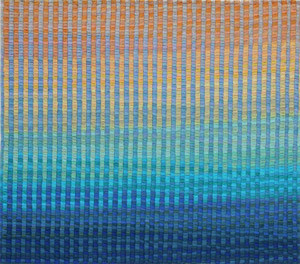
Broadstairs/Sunset, 2009 (173 x 197 cm)
“Transforming passing time into a visible object” is how Inge Hueber describes the experience of creating her artwork. While her early work focuses on her invented variations on Seminole piecing, Hueber´s recent work uses the nine-patch block as its inspiration, but replaces the usual square pieces with stripes. Certainly no one would mistake the German artist´s quilts for traditional designs: The palette of her own hand-dyed cottons, her rhythmic color placement, and her use of visible seams as embellishment mark these as contemporary works of art… Saying that she invents what she feels, Hueber uses the placement of color in her geometric creations to express how she sees the rhythm of life. The use of strip piecing expresses her approach to life – simple, straightforward, and full of verve.
“From the beginning, I have dyed all my material, and I have learned a lot about the special language of colored cloth. I am still fascinated and often surprised by the quilting process – for example, realizing the potential of visible seams to add texture and depth….My quilts are a technical construction on one hand, and a combination of emotional colors on the other. I am searching for a balance between textile flexibility, color values, intuition, and precise craftsmanship…My quilts have developed into a kind of visual diary. I cannot plan changes – they occur when they are due, just as in real life. Making quilts has given me a key to my own life, a key to open doors that would have been locked otherwise.”
Making Journeys, 2002
by Helen Joseph
Inge Hueber
Hueber’s commitment to quiltmaking is obvious. She is a self –taught artist, who through her work is driven to the dialogue between brain and the heart, looking to solve the problems of technique versus design.
Her strength lies in tow major areas, firstly her trust in her intuition, (“I arrange my pieces on my table and just wait and watch and hear, with my eyes, for those units ‘to start sing’ then I sew them together.”) and secondly her consummate skill in the use of colour and tone. For over twenty years she has been excited by the art of quiltmaking, building on her repertoire by experimenting with dyes but at the same time constructing her quilts by a relatively simple method, ‘strip piecing’. This is known as Seminole piecing, in which strips of different coloured fabrics are stitched together, cut apart, re-arranged and then sewn together again. Hueber’s trademark is to using hand dyed cotton. … As all quiltmakers know, whether ‘grass root’ or professional, the activity of cutting, stitching, arranging and piecing fabrics is immensely satisfying, (if at times deeply frustrating) and in Hueber’s hands this process is meticulously carried out. … The body of work that Hueber produces can be seen in a series and since the mid-nineties she has increasingly played with the ‘interrupted square’, fascinated by the opportunities that this simple shape offers. By shifting and rearranging this module she takes the viewer into a dance; sometimes a jig as in ‘Ikat Quilt Rhythm II’ and sometimes into a ‘waltz’ in ‘Colours Singing in the Sun’. Throughout her work runs an incessant beat which becomes graphically and boldly seen, but beneath the surface, lie the complexities of structure and illusion, which have evolved through many years of practice. In essence she ‘paints’ the textile surface with dyed strips of fabric, using rhythmic patterns to confuse and delight the eye.
Quilt Art 20 years (catalogue/book 2005)
We exist since 20 years!
This is in itself an achievement although our greatest dreams did not come true. The potential of patchwork and quilting is only discovered in small steps but our group is alive and represents a mixture of backgrounds and aims. After my lonely start in 1980 in Cologne, Germany, Quilt Art offered me not only a group to work with, but another language and culture. Since then a world wide web of coherences and connections has built up and, as a founder member, I am grateful to be a part of it from the beginning.
The world has changed in these twenty years, it has got faster, more virtual and less real, but we stick to a slow process and transform passing time into a visible object. In quiltmaking we invent, we produce and we communicate and these are some of the essentials of human activity.
I invent what I feel – the rhythm of life, changing emotions into colours and cloth. And I love to produce, sticking to strips and stripes. To communicate and connect is getting more important in my mind, and this is now made easier by electronic mailing and less expensive travelling.
The catalogue of Quilt Art 2001
Moving On
by Inge Hueber
I love strips and stripes: they are simple, straight-forward, everywhere and full of verve. For many years my work-space has been covered with lots of strips and for many years I picked just two colours to make long bands of five strips, which I re-cut into squares. But this time I have started to recycle my own material and cut up left-over squares into small strips. Four of these narrow strips make up a chequered module, a small unit, again nearly a square. I arrange them on my table and just wait and watch and hear with my eyes for these units to “start to sing”, then I sew them together.
I love colours and like to plan and to organise, these two elements are essential to my quiltmaking alongside my pleasure in networking and communicating with others. I like to dye, to cut with my scissors, to sew and to quilt (this time by machine) – a slow process full of repetitions and in a certain rhythm. In between the colours shine and I wonder how they act and react and interact.
New ideas, new concepts never occur sitting in my studio. They jump up when I’m not expecting them, sitting in trains or trams for example. I do not write them down, what I forget, I forget. Only ideas which stay alive will go into my next quilt.
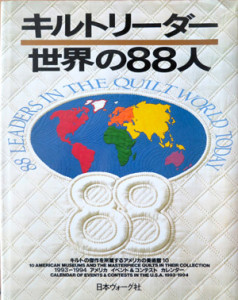 “88 Leaders of the Quilt World Today”
“88 Leaders of the Quilt World Today”
1994 Tokyo/Japan
„Since the Middle Ages, our Western culture turned to the abstract, to theory and written words. Textiles, on the contrary, still offer touch, warmth and sight. Without words we can communicate with material that is familiar to all of us. There is this emotional and sensual side of a quilt, a language which all of us understand.
However, there are different styles of patchwork in different countries.Especially in England and the United States, patchwork is a well established tradition. In these countries, quilters build upon firm ground and want to continue what others started a long time ago.
In Germany, we have many textile traditions, but patchwork did not develop. Germans used to sleep under feather beds to keep warm. We do not have special childhood memories of sleeping under a soft quilt made by our mothers. But these obvious disadvantages are an advantage at the same time. Without a tradition, you do not have to follow one. German quiltmakers could start from the very beginning with a lot of freedom. Fifteen years of my own quilt making have changed a lot in my life, working in „splendid isolation“, but living in a city of one million inhabitants. I gradually came to know about quilts, learning the techniques by trial and error. Using a very typical female material has been a natural decision for me. You choose what you know. Following a way which has been started already by other women is easier than inventing by yourself. This long established familiarity with textile materials helps to take risks and to try an individual way.
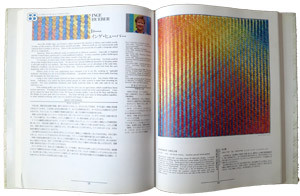 With making quilts I got a key to my life and a key to open doors, which would have been locked otherwise. Traveling and lecturing in other countries turned out to be a great pleasure.I may go to a place far away, but when I enter the house of another quilter, I can sit on the floor and discuss the design of a new quilt after five minutes. This book will help even more to bring quilters together, to enjoy mutual exchange and I am grateful and happy to take part.“ (Inge Hueber, Cologne 1994)
With making quilts I got a key to my life and a key to open doors, which would have been locked otherwise. Traveling and lecturing in other countries turned out to be a great pleasure.I may go to a place far away, but when I enter the house of another quilter, I can sit on the floor and discuss the design of a new quilt after five minutes. This book will help even more to bring quilters together, to enjoy mutual exchange and I am grateful and happy to take part.“ (Inge Hueber, Cologne 1994)
Quilters’ Review, Winter 1993
“I am very bourgeois, really” – The birth of a German quilter
by June Freeman
Inge Hueber’s story has the makings of a good feminist fairy story. On her own account her decision to become a quilter represented a final realisation of long-felt artistic needs and a flowering of an independent personal identity. … The fact that textiles lack status in the art world also seemed an advantage. “No-one is interested in textiles so it is a wonderful open world.” She had, as Germans would put it, ‘found a white spot on the map’. This, together with her newfound sense of ability, gave her a determination and assurance she had hitherto lacked. … “Earning money is a really important thing for many women. They feel much better…having their own earned money though they don’t need it…it’s not important for me…what I get from quilts I could not buy with money.” The nice middle-class girl has, in middle age, become a person in her own right. She continues to benefit from and take advantage of her liberal background, but no longer passively. … After some struggles with her ‘bourgeois’ inclinations she decided that the most effective thing was to turn her quilts back to front. As a meticulous and beautiful sewer she had to take a deep breath to do this. But she was pleased with the result. … There still remain important constants in her work. Her most recent quilts continue to reflect the aura and ambience modern urban life holds for her; she continues the technique of strip-piecing and cutting to express this and her range eschews the dark side of life. Inge Hueber has already given us some alluring work and we cannot fail to be interested in what this professional and imaginative quilter will produce in future.
Lichtblicke – Textile Strukturen
Inge Huebers’s Art of Quilting
by Harald Weinrich
The old patchwork-art from America and England grew out of bourgeois thrift. But, as is often the case, the loveliest flowers sprout from the poorest soil. They were made from small pieces of cloth, carefully collected, which were cut into little patches and sewn together by hand.
Inge Hueber, as a German quilter, is separate from this Anglo-Saxon tradition and must dispense with the security and the support of the well proved technique, but she recognized her chance in this outsider’s role, in a new freedom. She breaks away from the idea of recycling old patches in a quilt. “With a feeling of ecstasy”, she later recalls, she bought 100 meters of white cotton in a London shop. Since then, cotton has been her medium, as she explains: “I love this plain simple material. It is not just attractive, it grows old gracefully and can be handled with facility.”
To these qualities, which are typical for cotton, she adds her personal characteristic touch. She starts to dye piece by piece to get her own colour palette. In more than ten years she has gradually enlarged her repertoir of colours with many more shades.
Hand-dyed cotton is Inge Hueber’s trademark. But while this choice for a material of her own has existed from the very beginning, her first quilts still respected traditional designs. But soon her creativity did not remain with the summary and tranquil proportions of the traditional way of expression. She developed her imaginative ideas and began to articulate her own artistic language. The static-geometric shapes are transformed into a variety of dynamic assymmetrical designs and free configurations.
The Seminole-technique has developed for Inge Hueber as an important structural element, named after an Indian tribe still living in Florida. In this technique, strips of different colours are sewn together, cut apart, then shifted and sewn togehter again. This traditional method is used by the artist in a free way and is further developed in her own individual manner, with many variations.
Inge Hueber’s quilts are works of art, which reflect in all their phases the perfection of craftmanship and the inventiveness of their creator, but which, in the end, give the impression of being released from their own history and set free from all material limitations. In this way, the artist has created a textile language of her own, which knows no linguistic barriers, and her serene texts require no translation.
